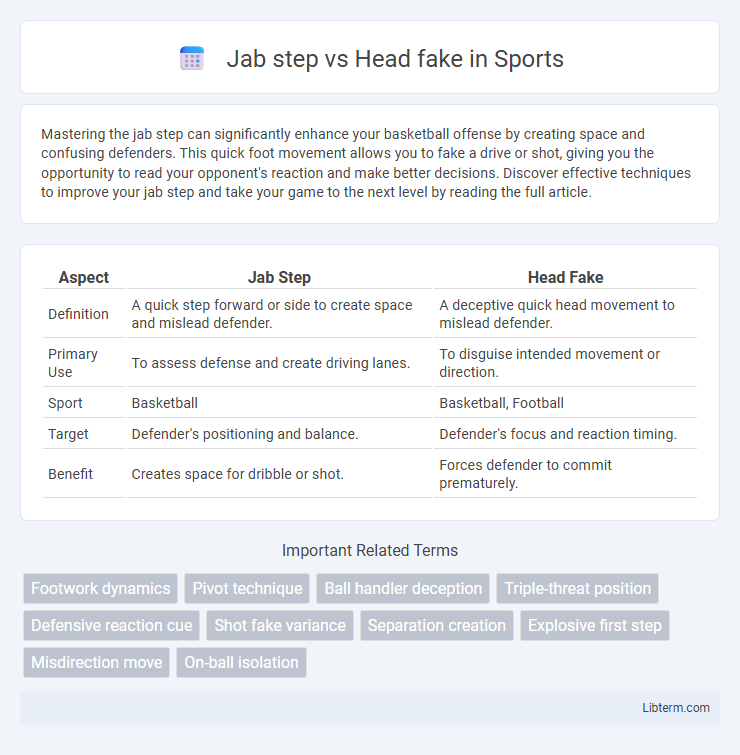Mastering the jab step can significantly enhance your basketball offense by creating space and confusing defenders. This quick foot movement allows you to fake a drive or shot, giving you the opportunity to read your opponent's reaction and make better decisions. Discover effective techniques to improve your jab step and take your game to the next level by reading the full article.
Table of Comparison
| Aspect | Jab Step | Head Fake |
|---|---|---|
| Definition | A quick step forward or side to create space and mislead defender. | A deceptive quick head movement to mislead defender. |
| Primary Use | To assess defense and create driving lanes. | To disguise intended movement or direction. |
| Sport | Basketball | Basketball, Football |
| Target | Defender's positioning and balance. | Defender's focus and reaction timing. |
| Benefit | Creates space for dribble or shot. | Forces defender to commit prematurely. |
Introduction to Jab Step and Head Fake
The jab step is a fundamental basketball move involving a quick step toward the defender to create space or provoke a reaction, enhancing offensive positioning. A head fake, by contrast, uses a sudden, deceptive movement of the head to mislead defenders about the player's intended direction or action. Both techniques aim to manipulate defensive responses, improving scoring opportunities and ball control.
Defining the Jab Step in Basketball
The jab step in basketball is a quick, deceptive move performed by a player with the ball to create space or assess a defender's reaction without committing to a full dribble or drive. It involves a sharp step forward with a lead foot while maintaining balance and readiness to shoot, pass, or drive, optimizing offensive positioning. Unlike the head fake, which uses upper-body movement to mislead defenders, the jab step strategically manipulates footwork to gain tactical advantage on the court.
Understanding the Head Fake Technique
The head fake technique in basketball involves a rapid, intentional movement of the head to mislead the defender about the player's next move, creating space or an open lane. Unlike the jab step, which uses footwork to fake a direction, the head fake relies solely on visual deception, often combined with upper body movement to enhance believability. Mastering the head fake requires precise timing and body control to effectively manipulate the defender's anticipation and gain a tactical advantage.
Key Differences Between Jab Step and Head Fake
The jab step uses a quick, focused foot movement to gauge defender reactions and create shooting or driving opportunities, emphasizing precise foot placement and body control. The head fake employs a sudden, exaggerated head and upper body motion to deceive the defender's attention, aiming to misdirect and open space for a move. Key differences lie in the jab step's foot-centric approach versus the head fake's upper body deception, with the jab step offering more immediate positional advantage and the head fake prioritizing visual misdirection.
When to Use Jab Step vs Head Fake
Use a jab step when you want to gauge your defender's reaction and create space for a quick drive or shot, making it ideal for orchestrating offensive moves in basketball. Employ a head fake to deceive your opponent's balance by pretending to move in one direction before quickly shifting to another, useful during close-quarters offensive plays. Jab steps are effective for setting up plays and maintaining offensive rhythm, while head fakes excel in sudden directional changes to outmaneuver tight defenders.
Benefits of Using the Jab Step
The jab step enhances offensive versatility by creating hesitation in defenders, enabling easier drives and shot opportunities. It improves spacing and timing, allowing players to exploit defensive weaknesses without committing to full movement. Using the jab step also conserves energy and maintains balance, contributing to more effective and controlled offensive plays.
Advantages of the Head Fake Move
The head fake move creates a powerful psychological advantage by misleading the opponent about the player's intended direction, enhancing offensive unpredictability. This technique increases the likelihood of breaking defensive stances and opening up scoring opportunities by exploiting the defender's reaction to the false movement. Compared to the jab step, the head fake more effectively manipulates spatial perception, enabling quicker and more successful attacks in basketball or other sports.
Common Mistakes with Jab Steps and Head Fakes
Common mistakes with jab steps include telegraphing the move by overextending the lead foot or arm, making it easier for defenders to anticipate and react. Head fakes often fail when players exaggerate the motion too much or fail to control their upper body properly, resulting in loss of balance or commitment to the fake. Both techniques require precise timing and subtlety to avoid becoming predictable or losing offensive advantage.
Training Drills for Improving Jab Step and Head Fake
Effective training drills for improving the jab step include cone or marker exercises that enhance footwork precision and balance, allowing players to deceive defenders with quick directional changes. Head fake drills often involve mirror exercises and partner reactions to sharpen upper body control and develop convincing head and shoulder feints. Combining these drills on the court promotes agility, timing, and the ability to manipulate defensive positioning in basketball offense strategies.
Conclusion: Mastering Offensive Basketball Fakes
Mastering offensive basketball fakes like the jab step and head fake enhances a player's ability to create scoring opportunities by deceiving defenders effectively. The jab step uses a quick foot movement to test defender reactions and create space, while the head fake employs upper body deception to manipulate defensive positioning. Proficient use of both techniques significantly improves offensive versatility and scoring efficiency on the court.
Jab step Infographic

 libterm.com
libterm.com